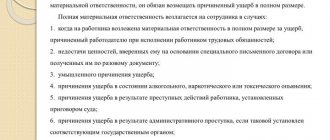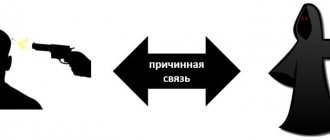Theft is an unlawful gratuitous seizure and (or) conversion of someone else's property for the benefit of the perpetrator or other persons, committed for mercenary purposes, causing damage to the owner or other holder of this property.
Signs of theft:
— seizure and (or) circulation of someone else’s property;
- selfish goal;
- gratuitousness;
- illegality.
Seizure - rejection, separation of part of the property from the total property mass in the possession of the owner or the person in whose possession it is.
Treatment is the establishment of actual possession of a thing, the use of inventory items in the interests of the culprit himself or other persons.
Illegality means that the perpetrator is not the owner of the property, did not have the legal right to seize the property and use it for his own benefit, and was not authorized to do such an action.
Gratuitousness - the owner does not receive the necessary equivalent for the property removed from his possession in the form of socially useful labor or compensation for the value of the item of theft.
Selfish purpose is the desire to convert stolen property in favor of the perpetrator or other persons.
Someone else's property is property that is not owned or legally controlled by the offender, either in whole or in part.
Forms of theft (by method of seizure or circulation of property):
— theft;
- fraud;
- misappropriation and embezzlement;
- robbery;
- robbery.
The subject of theft is someone else's property, that is, not in the ownership or legal control of the culprit, things of the material world that have value or human labor is embodied in them.
Signs of theft:
- physical - these are objects of the material world that have general physical characteristics (size, weight);
- economic - human labor is invested in the creation of a thing, which is expressed in value;
- legal - the property is under the right of ownership of another person (ownerless property is not the subject of theft).
Types of items stolen
General items:
- things;
- money;
— securities (except registered).
Items prohibited for civil circulation:
— weapons, ammunition, explosives or explosive devices;
— narcotic drugs and psychotropic substances;
— radioactive materials;
— documents, seals, forms, stamps, state awards.
Theft concept
In order to formulate the concept, signs, and types of theft, it is necessary to study not only the current legislation, but also refer to the previous system of bills.
At all times, among all peoples, including the ancients, the basis of criminal law was property offenses and attacks on human life. As for Russian justice, the term “theft”, described in important laws and decrees of past centuries, initially played an important role (the Council Code of 1649, the Decree of Catherine II “On trial and punishment for theft of various types” of 1781).
In 1845, the first set of laws on criminal liability in Russia appeared, in which the generic term “theft” was replaced by “theft,” the signs, forms, types of which were described and supplemented in subsequent bills of criminal law.
Theft in the modern interpretation means a set of crimes committed for selfish reasons, aimed at the deliberate and irrevocable seizure of someone else's property in favor of the criminal.
Signs of theft
All forms and types of theft combine a number of fundamental features, including:
- Selfish goal. The sign assumes that the perpetrator or a group of perpetrators commits an illegal act for personal reasons with the desire to obtain material benefit for themselves or third parties. An example of a selfish offense: appropriating someone else’s property for the purpose of enrichment (wallet). In the history of jurisprudence, there have been cases of theft of other people's material resources and property for the purpose of distributing them to needy people (the poor).
- Wrongfulness is an illegal act committed by a criminal who, according to current legislation, has no right to gratuitously seize the things of another citizen who has the legal right of ownership of this property.
- Gratuitousness occurs when the offender appropriates ownership of someone else's thing without compensation for its value or compensation acceptable to the other party in the form of barter or any services.
- Seizure involves the transfer of property or the right to it from the legal owner to another person without the consent of the first. As a result, the owner’s property fund decreases, which is a fact of damage to his financial condition. At the same time, the form of ownership (private, state) is not a significant factor in qualifying theft.
- Damage in the form of a decrease in the victim’s assets plays an important role in qualifying theft; it is its size that determines the form and severity of the offense. However, it should be noted that the amount of damage is established only in accordance with the illegally seized property, but not the lost profits associated with it. For example, if an employee stole some equipment from a company, then he must return only the equipment or its cost, and the amount of damage will not include the amount of losses the company incurred due to production downtime due to the absence of this piece of equipment.
Corpus delicti
The concept and signs of theft (note to Article 158 of the Criminal Code):
- Seizure (turnover) of someone else's property.
- Illegality of seizure. For example, the accused forcibly took away from the victim a previously lent amount of money. In this case, it is not the fact of seizure itself that is illegal, but the method of its implementation. Therefore, the actions of the perpetrator will be qualified not as theft, but as arbitrariness (Article 330 of the Criminal Code).
- No refund.
- Selfish motive.
- Damage caused to the property owner. What is meant is the amount of real losses, not lost profits. Compensation for the latter can be demanded from the perpetrator by filing a civil lawsuit.
An object
The crime affects social relations developing in the field of distribution of material values. It is directed against the property rights of the rightful owner of the property. When committing robbery, an additional object is the human right to health and physical integrity.
Item
The subject of the crime is someone else's property. In this case, property means the following items:
- The material world, having a real form and physical characteristics. This also includes money, including non-cash, and securities.
- Are the result of human labor. As a result, farmed fish and aquatic animals also fall within this definition. Illegal catching of such will be classified as theft.
- Having a certain value, expressed in monetary terms.
- Not withdrawn from circulation.
The list of fraud expands to include property rights. Since they can be transferred by the owner under the influence of misconception or incorrect information, which are not included in other types of theft in criminal law.
By someone else's property we mean:
- not belonging to the perpetrator:
- Based on legal documents.
- By right of actual use.
- By presumed right (for example, in the case of appropriation of one’s own wages from entrusted funds).
- having a specific owner.
Property not the subject of a crime
The following property cannot be classified as the subject of theft:
note
For the theft of electricity, in addition to administrative liability, there is also criminal liability - a case is initiated in the event of damage to power lines or structures. And if in the first case, the offender may be limited to a fine of 10 to 15 thousand rubles, if a criminal penalty is imposed, he may face imprisonment for up to 3 years. Read more on our website
- Having no material expression:
- Intellectual property, the misappropriation of which is punishable under Art. 146 of the Criminal Code (copyright infringement).
- Electrical or thermal energy. In this case, the perpetrator may be held accountable under Art. 165 of the Criminal Code for causing material damage through deception and abuse of trust. For example, for non-payment of utilities used in someone else’s apartment, or unlawful use of devices entrusted in connection with official duties.
- Computer data that is the subject of Art. 272 of the Criminal Code (illegal acquisition of computer information).
- Which has no intrinsic value, but gives the right to receive money or property, which does not include the concept of theft, forms and types of theft:
- bank books;
credit cards;
- electronic codes for storages;
- keys to an apartment or car;
- luggage receipts;
- coupons from locker rooms;
- invoices;
- checks.
- Withdrawn from circulation and considered as part of other crimes (Articles 221, 226, 229, 325 of the Criminal Code):
- nuclear and radioactive materials;
- certain types of firearms;
- some types of narcotic and psychotropic substances;
- documentation.
- Shared or jointly owned . Such property is not divided between the owners into specific material parts, and in relation to it it is impossible to apply the concept of someone else's property.
- Considered abandoned, since the owner:
- absent;
- unknown;
- renounced ownership.
If these items were stolen for the purpose of further appropriation of someone else's property, this act is regarded as preparation for a crime.
Objective side
It is the objective side of various forms of theft that has distinctive features that make it possible to identify the crime.
Theft
The least dangerous type of theft is theft, the crime of which does not contain violence. Theft of property is committed secretly, that is, when the owner or other unauthorized persons:
- absent;
- are at the crime scene, but do not notice the actions of the perpetrator;
- observe the process of theft, but do not realize its illegality;
- are fully aware that the theft has been committed, but the defendant does not know about it and is sure that he is acting secretly.
Fraud Fraud is characterized by the taking of someone else's property through deception or gaining the trust of the owner. The victim himself hands over the property to the defendant, being misled as to his true intentions. For example, he gives him money as an advance payment for the delivery of goods. This crime is the only type of theft, the subject of which can be not only the property itself, but also the right to it. And in the latter case, the classification of theft does not occur unconditionally.
Criminals also use a method called telephone fraud - with its help, extortionists gain the trust of the victim and force her to transfer money to them. We will tell you more about types of telephone fraud and protection against deception in the article here https://lexconsult.online/7095-telefonnoe-moshennichestvo-kak-raspoznat-obman-vernut-dengi
Misappropriation or embezzlement In the objective side of misappropriation and embezzlement, there is no direct seizure of property. The owner, in accordance with his own interests, instructs the attacker to dispose of the property in a certain way. For example, to manage it, ensure its safety or delivery to the desired address. In this case, the differences in the concept of theft of property and its characteristics are as follows:
- When embezzlement, the offender unlawfully retains someone else's property entrusted to him and treats it as if it were his own.
- Embezzlement occurs when the offender spends someone else's property under his control or transfers it to third parties.
Robbery Robbery is carried out openly, through the active actions of the accused and in the presence of the owner or strangers.
Robbery In robbery, the culprit also acts openly, without hiding from others. The difference from robbery lies in violent actions that pose a danger to the life and health of the victim or threats to carry out such actions. Read more about the concept and composition of this crime in a separate article https://lexconsult.online/8621-razboi-ponyatie-i-sostav-prestupleniya
The end of the crime
An unlawful act is considered completed when:
- Theft and robbery - at the moment of transfer of stolen property into illegal possession. As follows from the concept and signs of theft of someone else's property, this moment comes when the criminal receives a real opportunity to dispose of it in his favor or for other persons.
- Fraud - when an attacker legally formalizes the right to dispose of someone else's property.
- Appropriation - from the beginning of the commission of actions that convert the entrusted property in favor of the defendant. For example, from the execution of a forgery to conceal property, or from the moment of making a decision not to place entrusted funds into a bank account.
- Embezzlement - from the moment of use, expenditure or sale of entrusted property.
- Robbery - at the time of an attack, accompanied by violence dangerous to life and health, or threats of this violence. That is, the robbery will be completed, even if the attacker fails to take possession of the victim’s property.
Subject
The subjects of theft differ depending on its type:
- A person who has reached 14 years of age is responsible for committing theft, robbery or robbery (Article 20 of the Criminal Code).
- Persons aged 16 years and older are charged with fraud.
- Misappropriation and embezzlement is punishable by a person over 16 years of age to whom property was entrusted in accordance with official duties. This could be a salesperson, cashier, storekeeper or supply person.
- Responsibility for the theft of objects of special cultural or scientific value begins at the age of 16 (Article 164 of the Criminal Code). Persons under the specified age are punished under other articles, depending on the type of theft committed (Articles 158, 161, 162 of the Criminal Code).
Item of theft
The concept and types of theft are closely related to the subject of theft, which can be any other person’s property, illegally seized or appropriated by a criminal. The item of theft must combine three characteristics:
- Physical properties - the item of theft is materially delineated in space (that is, it is in a solid, liquid or gaseous state, animate or inanimate).
- Legal aspect. Property must be legally owned by someone
- The economic component means that the property has a value.
Signs of someone else's property
To understand where property rights will be violated, you need to know the distinctive features of someone else’s property, and they are as follows:
- A real sign. Means that any property is an object of the material world.
- Economic sign. Personal or government objects extracted from natural reserves have some value. For example, securities and cash can also be classified as objects of theft.
- Legal sign. The perpetrator of the crime is not the owner of the property he is trying to or has already stolen.
Forms and types of theft
Forms of theft are grouped in the Criminal Code of the Russian Federation according to the methods and features of committing property crimes:
- Theft (Article 158 of the Criminal Code of the Russian Federation).
- Fraud (Article 159 of the Criminal Code of the Russian Federation).
- Embezzlement or misappropriation (Article 160 of the Criminal Code of the Russian Federation).
- Robbery (Article 161 of the Criminal Code of the Russian Federation).
- Robbery (Article 162 of the Criminal Code of the Russian Federation).
Based on the amount of damage caused to the property owner, Russian criminal legislation distinguishes the following types of theft of someone else's property:
- Petty theft, the amount of damage of which is no more than 1000 rubles.
- Theft that caused minor damage to the owner in the amount of 1000 to 2500 rubles.
- Causing significant damage, the amount of which can reach up to 250,000 rubles.
- Major thefts up to RUB 1,000,000.
- Particularly large types of theft - more than 1,000,000 rubles.
Violent offense
Robbery
Basic elements of the crime
The objective side of robbery is the commission of open actions aimed at stealing someone else's property. That is, the act is committed in the presence of the owner of the property or in front of witnesses . The perpetrator realizes that the witnesses understand the criminal nature of these actions.
Robbery is a more dangerous form of theft, and therefore the punishment for it is more severe. Minimum responsibility begins with mandatory work (up to 480 hours). The maximum penalty is imprisonment for up to 4 years.
Qualified (Part 2)
- A group of persons by prior conspiracy.
- With illegal entry into a home or other premises.
- Using non-life-threatening violence.
- The threat of such violence.
- Large size.
In general, the qualification will be made in the same way as for theft. The distinctive element is the use or threat of violence .
The use of non-dangerous violence or its threat - the category of non-dangerous violence is deciphered in PPVS No. 29 “On judicial practice in cases of theft, robbery and robbery.” This may include beatings, causing physical suffering to the victim, or restricting his movement. These actions should not result in permanent harm to health. The offender faces up to 7 years in prison for committing these actions.
Accused V., being intoxicated, snatched the minor victim from the hands. Mobile phone, worth 2,800 rubles. The victim tried to return the phone, but the accused, in order to keep the thing with her, pushed him in the chest, causing physical pain, and then disappeared. The phone was later sold by her.
The court, taking into account V.’s outstanding criminal record, qualified her actions under paragraph “e” of Part 2 of Art. 161 of the Criminal Code of the Russian Federation and imposed a sentence of imprisonment for a period of 2 years 6 months.
Particularly qualified (part 3)
It consists of two types: committing an act by an organized group and robbery on an especially large scale. The qualification rules are the same as for theft . The perpetrators face from 6 to 12 years of imprisonment, and in addition to this, the court may additionally impose a fine or restriction of freedom.
Robbery
Basic
In contrast to the forms of theft listed above, during robbery there are two main objects of the crime: in addition to social relations that ensure the protection of property, the object is the life and health of the victim.
The objective side of theft in criminal law is not the seizure of property, but an attack with the aim of obtaining someone else's property. It is carried out with violence dangerous to life or health, or with the threat of its use.
Differences are also expressed in the construction of the crime. Robbery is an act with a truncated composition . The moment of the end of the crime passes to the moment of the beginning of the robbery. Considering the social danger of such a crime, liability for it is severe and without qualifying criteria - up to 8 years in prison.
D. committed a robbery. While in an electronics store, he asked the seller to look at a tablet computer worth 2,000 rubles. After the tablet was in his hands, D. punched the seller 4 times in the face and a blow to the head, thereby causing minor harm to health, which did not cause short-term health problems. After that, he fled with the stolen goods.
The act is classified as assault with threat of bodily harm. Taking into account the admission of guilt, the court sentenced D. to imprisonment for a term of up to 2 years.
Skilled
- A group of persons by prior conspiracy.
- Use of weapons or objects that may be considered such.
- A group of persons by prior conspiracy . The qualification rules repeat a similar act when committing theft.
- Use of weapons.When using weapons, you must be guided by Federal Law No. 150 “On Weapons”. Additional qualifications under Art. 222 of the Criminal Code of the Russian Federation is required only in the case when the object used in the attack really is such. Under objects that can be used as weapons, any devices that have the property of causing harm (kitchen knives, razor, ax, etc.) can be used. ), as well as items for temporarily defeating a target (pepper spray, aerosol devices).
In cases where the perpetrator uses a fake weapon, its models or toy versions, and the victim realized the unsuitability of such a weapon, the act will be classified as robbery.The described actions are punishable by imprisonment for up to 10 years (plus additional punishment).
Particularly qualified
Robbery committed with penetration into a home or other premises, as well as on a large scale, is classified according to the rules of theft and robbery. Imprisonment is imposed from 7 to 12 years with or without additional penalties.
Theft
Theft is the secret appropriation of someone else's property, contrary to the law of the country. The basis of such a crime is the non-violent appropriation of material and non-material benefits that are alien to the perpetrator. In this case, theft is qualified as secret only if the offender acted in the absence of the owner or while in the presence of the owner or other persons who did not reveal their presence at the time of the crime. Subjects convicted of committing this offense can only be persons over 14 years of age.
What can be the subject of theft
We have already figured out what theft is, now we will consider what tangible assets can be called the object of theft. According to the provisions of the article in question, not every theft is called theft. Criminal punishment is provided only in cases where the value of the stolen item is more than 1,000 rubles. If its cost is less, then the offender is punished under other articles, namely according to the norms of the Code of Administrative Offenses of the Russian Federation.
Other articles also cover the theft of weapons, documents, withdrawal of funds from a company’s turnover, theft of narcotic drugs or radioactive substances. But if the criminal was engaged in theft from an oil or gas pipeline, then this is also considered the object of theft.
Robbery
Robbery is more dangerous than theft, fraud and embezzlement because it involves the unlawful taking of property in the presence of the owner or other persons aware of the criminal's intentions. In turn, the perpetrator also sees the presence of the victims, but continues the offense, which, however, is non-violent. Moreover, robbery implies that the criminal initially wanted to commit an open seizure of someone else's property. Violence can be the actions of the perpetrator towards victims or persons who have the opportunity to prevent the commission of robbery. These actions are of a violent nature, but without significant danger to the life and health of eyewitnesses to the offense. Examples: infliction of physical pain, beatings, imprisonment.
Theft qualification, concept
Article 158. Theft - opens a block of articles of the Criminal Code of the Russian Federation on the theft of someone else's property. Part 1 of Article 158 of the Criminal Code of the Russian Federation contains the concept of theft - this is the secret theft of someone else's property.
The subject of theft is someone else's property - things, objects created by human labor and possessing material or spiritual value, money, securities; the subject can only be movable property.
Someone else's property has the following characteristics:
a) Property sign – property is objects of the material world.
b) Economic attribute - objects created or extracted from natural reserves by human labor and having value. Money and securities can also be the subject of theft. Various types of energy, natural resources, wealth in their natural state, documents, and legitimation signs are not subject to theft.
c) Legal sign - the property is obviously alien to the guilty party, he is not its owner or legal owner, the property is not jointly owned, and is not the subject of a civil dispute between the guilty party and other persons.
The subject of theft can be not only property, but also the right to property, and it is not necessary that it have some kind of proprietary attribute.
Theft of items withdrawn from circulation
The theft of items withdrawn from circulation is qualified by articles of the Criminal Code of the Russian Federation on crimes against public safety or public health.
The extraction of valuable natural objects in their natural state (illegal cutting of trees, extraction of valuable species of animals) are classified as environmental crimes.
In case of theft, property is confiscated without adequate compensation or at least without any disproportionate compensation.
According to the objective content, theft consists of two parts: the seizure of property from the owner or another owner (legal and illegal) and the conversion of someone else’s property in favor of the perpetrator.
An obligatory sign of theft is the illegal seizure of property by the perpetrator, which obviously does not belong to him. This means that the property in no way belongs to the thief and is not the subject of his dispute.
Signs of theft
An objective sign of theft is the occurrence of socially dangerous consequences, in the form of property damage for the owner and other persons. Theft is qualified by the degree of direct losses, that is, the value of the stolen property, but in the framework of civil proceedings the victim has the right to demand compensation for lost profits as a result of theft.
Mandatory subjective characteristics are direct intent and selfish purpose.
Whether the decision is secret is decided based on the subjective assessment of the situation of theft by the perpetrator himself. “The secret theft of someone else’s property (theft) should be qualified as the actions of a person who has committed an illegal seizure of property in the absence of the owner or other possessor of this property, or unauthorized persons, or although in their presence, but unnoticed by them. In cases where these persons saw that a theft was being committed, but the perpetrator, based on the surrounding situation, believed that he was acting secretly, the act also constituted a secret theft of someone else’s property” (clause 2 of the resolution of the Plenum of the Supreme Court of the Russian Federation dated December 27, 2002 “ On judicial practice in cases of theft, robbery and robbery" // BVS RF. 2003. No. 2).
Theft (and all other forms of theft, except robbery) is considered a completed crime from the moment when the culprit seized someone else's property and received a real opportunity to use it or otherwise dispose of it at his own discretion (clause 6 of the resolution of the Plenum of the Supreme Court of the Russian Federation of December 27, 2002 year “On judicial practice in cases of theft, robbery and robbery” // BVS RF. 2003. No. 2).
Robbery
Robbery is the most socially dangerous seizure of someone else's property, which is based on the violent appropriation of the property of other persons. The robber uses threats and violent actions that can be dangerous not only to the health of the victims, but also to their lives.
As an illegal action, a criminal can use both a hidden and an open attack on the owner of the property or another person in whose department it is located (for example, a watchman). It should be noted that a threat to the life and health of the victim is not the object of this form of theft and requires separate qualifications.
Robbery
This type of theft, unlike theft, is committed openly. To be recognized as such, it is necessary that the owner or another person witnesses the unlawful act and the perpetrator of the crime understands that he is deliberately ignoring this circumstance.
Robbery can be committed by force. In this case, the criminal person not only claims someone else’s property, but also violates the integrity of the person. Such acts fall into the category of serious crimes.
Fraud
Fraud is the theft of someone else’s property and/or property rights through deception or abuse of the owner’s trust. Active deception is a lie with which a fraudster misleads the owner about the transfer of property rights. It can manifest itself in the form of forged documents, which as a result transfer property or the right to it to the criminal without the knowledge of the owner. Abuse of the owner’s trust also creates the illusion that the action is taking place in his favor, but in fact leads to the fact that the owner, without realizing it, transfers his property to the fraudster. The only difference is that in this case the perpetrator acts on the basis of trust in property.
Examples of such situations: non-repayment of debt or leased equipment, failure to fulfill obligations by the contractor, etc.
Amendments to the law are expected
The State Duma considered the issue of punishment for minor offenses. Often the guilt does not correspond to the seriousness of the conviction. The bill proposes to revise the information in punishment cases on the amount of theft, raising the bar to 5,000 rubles. For the misappropriation of someone else's property over trifles, fines and administrative arrests will be removed, only correctional labor will remain.
The innovations will not affect “masters” with qualifications who commit crimes:
- Pocket;
- apartment;
- group.
Repeat offenders will be strictly prosecuted:
- 80,000 rub. fines;
- 360 hours of correctional labor;
- 2 year imprisonment.
A second similar offense is accepted as a relapse if products worth 1,000 rubles per year are stolen.
The new provisions are still at the development stage; the document has not been formed and has not been read. It is created for citizens who, for example, mistakenly did not place a carton of milk in front of the cashier; they do not have a constant habit of forgetting to pay for the goods they took. Sellers work in stores, and they are financially responsible for the safety of the product range. After the audit, the shortage is divided among all employees, so unscrupulous buyers are noticed by aggressive staff.
Distinguishing theft from robbery and robbery is one of the most common problems solved daily by law enforcement officers, lawyers, and judges. Despite the most detailed regulation of this issue in the legal literature and Resolutions of the Plenum of the Supreme Court, the circumstances of specific criminal cases are as diverse as life itself, and to correctly resolve this issue, a clear understanding of the legal essence of both forms of theft is necessary, as well as an understanding of the principles of their delimitation.
By theft, the law understands this type of theft of someone else's property when its gratuitous seizure occurs secretly from the owner or he does not realize that his property is being taken from him unlawfully. The Criminal Code of the Russian Federation (Article 158) regulates the classification of this type of theft.
The act is classified:
- by composition of persons;
- according to the size of the stolen item;
- at the location of the stolen property.
The PVS resolution on acquisitive crimes provides that the difference between theft and other types of theft lies in the secrecy and secrecy of the theft.
This secrecy can be objective or subjectively perceived by the criminal.
This provision can be illustrated with examples from specific criminal cases.
For example, in the absence of the owners, an apartment was opened and valuables and money were stolen. The owners, returning from vacation, called the police, and a criminal case was initiated. This is an example of classic theft.
Another criminal case is theft from a supermarket. The young man entered the supermarket as a buyer, but along with other purchases he grabbed a bottle of expensive cognac, which he hid under his clothes with the intention of taking it out of the store without paying.
The attacker was detained by supermarket security officers and handed over to the police. Despite the fact that there were many other people in the supermarket with the thief, they all did not pay attention to the moment the bottle was stolen from the refrigerator. In turn, the offender was sure that his actions were a secret, and no one would know about his intentions.
Thus, property is seized secretly from the owner, although in the presence of other people who do not suspect the illegality of the offender’s actions.
Here is an example of the secret theft of property from the owner himself, who, nevertheless, does not suspect that theft is taking place. A young man at a club meets a girl, whom he invites to his home at the end of the evening. After a pleasant continuation, the owner of the apartment falls asleep and only in the morning discovers that while he was sleeping, a charming new acquaintance disappeared along with valuables and a certain amount. In this case, the seizure of property occurred, although in the presence of the owner, but unnoticed by him.
Also read: Article for stealing money: what punishment faces
By analogy, we can give examples when the owner was under the influence of alcohol or drugs or, for other reasons, did not have the opportunity to realize what was happening and adequately perceive the commission of a crime.
As can be seen from the above examples, the fundamental fact when classifying theft as theft is the fact that the criminal seizes property against the will of the owner.
A common option is to qualify theft as theft based on the intent of the perpetrator. For example, an elderly man felt ill on the street and lay down on a bench. Taking him asleep, the attacker searches his pockets and takes away valuables and money.
The victim realizes that a crime is being committed against him, however, not daring to enter into conflict with the young and strong kidnapper and fearing the use of violence, the elderly man pretends to be asleep. In this case, the criminal, believing that he is acting secretly for the victim, commits a secret theft.
Robbery differs from theft in that during robbery the theft of property is committed openly to the owner or other people.
Open theft is recognized if the owner or other persons understand that a crime is being committed. To qualify, it doesn't matter whether they tried to stop the kidnapper or not.
The explanations of the Supreme Court in cases of theft, robbery and robbery also provide for the difference between robbery and robbery based on the danger of the violence used. Non-violent theft or the use of violence that is not dangerous to health characterizes the crime as regulated under Art. 161(robbery).
Features that influence the qualification of robbery: Despite the fact that the difference is obvious, there are often cases in legal practice when a crime that begins as theft then turns into robbery. That is, the thief’s intentions become obvious to the owner or other people. Such crimes include cases when the returning owners find the thief in the apartment and demand to return the stolen property, but he runs away when the victim, who was previously unconscious, comes to his senses and asks to stop the illegal behavior.
Robbery and theft - what is the difference and how to make the correct distinction?
Despite the fact that they have common features for all thefts, when answering the question of how theft differs from robbery, it is necessary to take into account both objective and subjective circumstances: It should also be noted how exactly theft differs from robbery or theft of other types.
If during theft, violence is almost never used against the owner, as well as other persons, then during robbery and burglary, violence or threats are often used as a method of confiscating someone else’s property.
As practice shows, when sending a criminal case to court, the investigator often classifies the crime “with reserve”, that is, under a more serious article for certain reasons:
- Traditionally, the effectiveness of law enforcement agencies is assessed by the number of serious crimes solved and sent to court. The investigator, as a rule, is not interested in what qualifications will be indicated in the verdict.
- Since the deterioration of the defendant’s position during the consideration of the case in court is not allowed, if the qualifications are dubious, the investigator will always act on the principle of “better more than less” and send the case to the court with qualification under a more serious article in the hope that “the court will correct it.”
Reclassification of the case during the investigation seems more problematic, but it is possible.
As a rule, in borderline cases, much depends on the testimony of the defendant himself, since only he can explain the details of his intent, if, of course, he admits guilt.
If the criminal’s intent included committing theft, and the charge was brought for robbery, then it makes sense to admit partial guilt during the investigation. During interrogation as an accused, you should explain your position and, if necessary, submit a request for investigative actions to support it. Let's look at an example.
The young man is accused of committing robbery under the following circumstances. Early in the morning he entered the cafe through a broken window. Having put some gourmet foodstuffs into his bag, he heard the key turn in the lock - the first cook had come to replace him.
The thief quickly climbed out through the window and started running. A cafe employee, turning on the light, saw the chaos, ran to the window, and, noticing a running thief in the distance, began shouting to him to return the stolen goods. According to the cook, he heard him, but still disappeared. Based on this testimony, a charge of committing open theft - robbery was brought.
During the investigation, the accused partially admitted his guilt and testified that he did not hear the cook’s screams and committed theft, that is, secret theft. The lawyer filed a petition to conduct an investigative experiment, during which it turned out that at such a distance the defendant could not hear the cook’s screams. The result was requalification from Art. 161 at station 158 part 2, that is, theft by entering the premises.
During the trial, reclassification to a less serious charge is also possible.
For example, the court heard a case of robbery committed by a group of young people under the following circumstances.
Several college students, being avid fans, attended the football game. After it was over, they met a fan of the opposing team, and a verbal altercation ensued between them, which escalated into a fight. The parties tried to prove to each other with their fists which football team deserved victory more.
The fight was not serious, they wrestled, pushed each other, and separated. After the conflict, a lone fan did not find a cell phone in his jacket pocket. This phone was subsequently seized from one of the college students involved in the conflict. It turned out that the victim took off his jacket before the fight, and one of the attackers pulled out a phone from his pocket. The case was sent to court under Art. 161 part 2, as robbery with the use of violence by a group of persons.
In court, the students' lawyers developed a unified position based on the fact that the cause of the conflict and fight was opposing opinions about football teams. During the fight, no demands were made on the victim; the phone was secretly stolen by one of the company members, who did not inform the others about it.
Violence during a fight was not a means of taking possession of property, which is what distinguishes robbery from theft.
This version was fully confirmed during the judicial investigation. The thief stated that when he saw the jacket lying there, he decided to check his pockets and found a phone. He took the phone for himself without informing others about it, thus committing a secret theft, that is, theft.
As a result, the verdict against him was made under Art. 158 part 2, the remaining participants in the incident were acquitted under Art. 161 part 2, although their actions contained elements of another crime - beatings.
Answering the question: “Theft and theft of other types - what is the difference?” — it is necessary to pay special attention to the intent of the perpetrator, which will help to avoid erroneous classification.
In Russian criminal law, theft, robbery, robbery are illegal acts against property. They were committed by theft for personal gain. Theft is the secret theft of property. Robbery is an open act. It is also aimed at appropriating someone else's property. Robbery is an attack. Its purpose is also the theft of someone else's property, which is committed with the use of violence that is dangerous to health or life, or under the threat of such action.
All these crimes have one thing in common. They are aimed at taking possession of other people's property.
Embezzlement or misappropriation
Embezzlement or embezzlement differs from other forms of theft in that the transfer (seizure) of property rights from the owner to the criminal does not occur; the offender only exercises the right to dispose of the property entrusted to his department.
Embezzlement involves the actual use (expenditure) of someone else's property, and appropriation is the illegal retention of property until its alienation.
Qualification of theft and responsibility for its commission
The Criminal Code of the Russian Federation reveals not only the concept of theft, forms and types of theft, but also methods of their qualification, as well as measures to suppress them. Liability for property offenses can be of two types: administrative and criminal. The first is established for socially harmful offenses, classified as minor types of theft. They can be carried out through theft, embezzlement or fraud, provided that the amount of damage caused does not exceed the average monthly salary of a citizen at the time of the crime. Criminal liability arises if socially dangerous types of theft have been committed, the amount of damage from which exceeds the threshold of 5,000 rubles.
Types of theft can be classified not only based on the amount of damage incurred, but also taking into account the frequency of offenses committed by the same criminal. Thus, petty thefts in the amount of less than 5,000 rubles, but committed repeatedly, will be prosecuted not by administrative, but by criminal liability. On the other hand, the preventive measure in this case will be established as for petty theft committed repeatedly, even if the amount of damage reaches the level of major theft. The exception is the option when each subsequent crime is committed in the same way as the previous one, and the investigation establishes the intent of the criminal to commit a large-scale seizure in total.
Types of theft
According to Article 158 of the Criminal Code, three types of theft are classified: simple, qualified and especially qualified. The most common type of theft is skilled theft. Several people act to commit such a crime, the theft is committed repeatedly, there is usually illegal entry into the home, as well as significant financial losses for the owner as a result of the crime. Aggravating circumstances will be considered the fact that the thief has been involved in thefts more than once, has served a sentence under the same article earlier (or for extortion).
Simple thefts are shoplifting, snatching purses from bags or pickpocketing, stealing a phone in a doctor's office, etc. Particularly skilled cases are rare, more often they can be seen on the screens of Hollywood films, when robbers bring a mountain of tools with them to the site , modern technology, opening complex safes, etc.
Burglary
These are the most numerous types of theft of people's property. The criminal, using a master key, picking keys, breaking or brazenly breaking the lock, enters the premises. This can also happen through a balcony or window frame, by climbing through a window or squeezing out double-glazed windows in plastic windows. Sometimes penetrations occur due to the naivety of the owners, when their trust is abused.
Apartment burglaries are rarely committed in a hurry. Preparatory work usually takes place in advance. Thieves can monitor the daily schedule of the owners of the living space for a long time, collect information, even know the mobile phone number and names of relatives, examine the lock on the door, select the key, so that on the day of the robbery they act quickly and not linger.
Finding such robbers is very difficult. The investigation of thefts begins with an inspection of the premises, taking prints on pieces of furniture, searching for shoe marks on the floor and from a car near the house. There may be scraps of the robbers' clothes left behind. Such an organized crime carries a penalty for theft of up to 6 years.
Theft of personal property
This type of theft includes pickpocketing money and phones, burglary, car theft, removal of license plates from a car, etc. You need to correctly understand what theft is and how it differs from robbery and robbery.
The theft is carried out secretly. If you see that your phone is being taken out in your transport, and this fact did not stop the thief at all, then we are talking about robbery. If strong guys came up to you on the street and, threatening to kill you, demanded that you give them your phone, then this is robbery. Sometimes bandits become so impudent that they can attack from behind and beat a person well for some phone or half-empty wallet. Here the punishment is completely different.
Theft of state property
This type refers to major thefts. Such crimes are committed at work, and budget funds are appropriated by both an individual and a group of individuals. There are even specially created companies that do nothing but rob budget funds. A criminal case for theft of state property is opened against both an individual criminal and an organized group. The punishment depends on the amount stolen.
If we are talking about a small amount stolen by a cashier from a bank, then the case may end with a fine in the amount of 5 monthly salaries or 2 years of correctional labor. But sometimes for large losses the court can sentence you to three years in prison.
Information theft
This paragraph of the article of the Criminal Code covers the appropriation of an artistic creation you have written, a song, an invented logo, a television show and much more. This could be any invention that another person stole from you. But there is one important point: you need to register and patent your invention, otherwise it will be very difficult to prove in court that this is your publication or novel.
Internet theft
With the advent of the World Wide Web, bank cards and payment systems via phones and computers, many smart criminals have appeared who are not averse to making money at your expense. In order to avoid becoming a victim of such crimes, you need to follow a few simple rules:
- It is not recommended to pay with a bank card on unfamiliar sites or unverified online stores.
- You cannot share your PIN or CVV codes with anyone.
- Carefully check messages, even if it says that they are from bank employees, then you need to carefully look at which page on the Internet they redirect you to.
- Do not enter the password unless you have checked everything thoroughly (be sure to double-check each digit of the number, since even one wrong digit will lead to loss of funds).
Also read: Features of Article 226 of the Criminal Code of the Russian Federation in simple words










